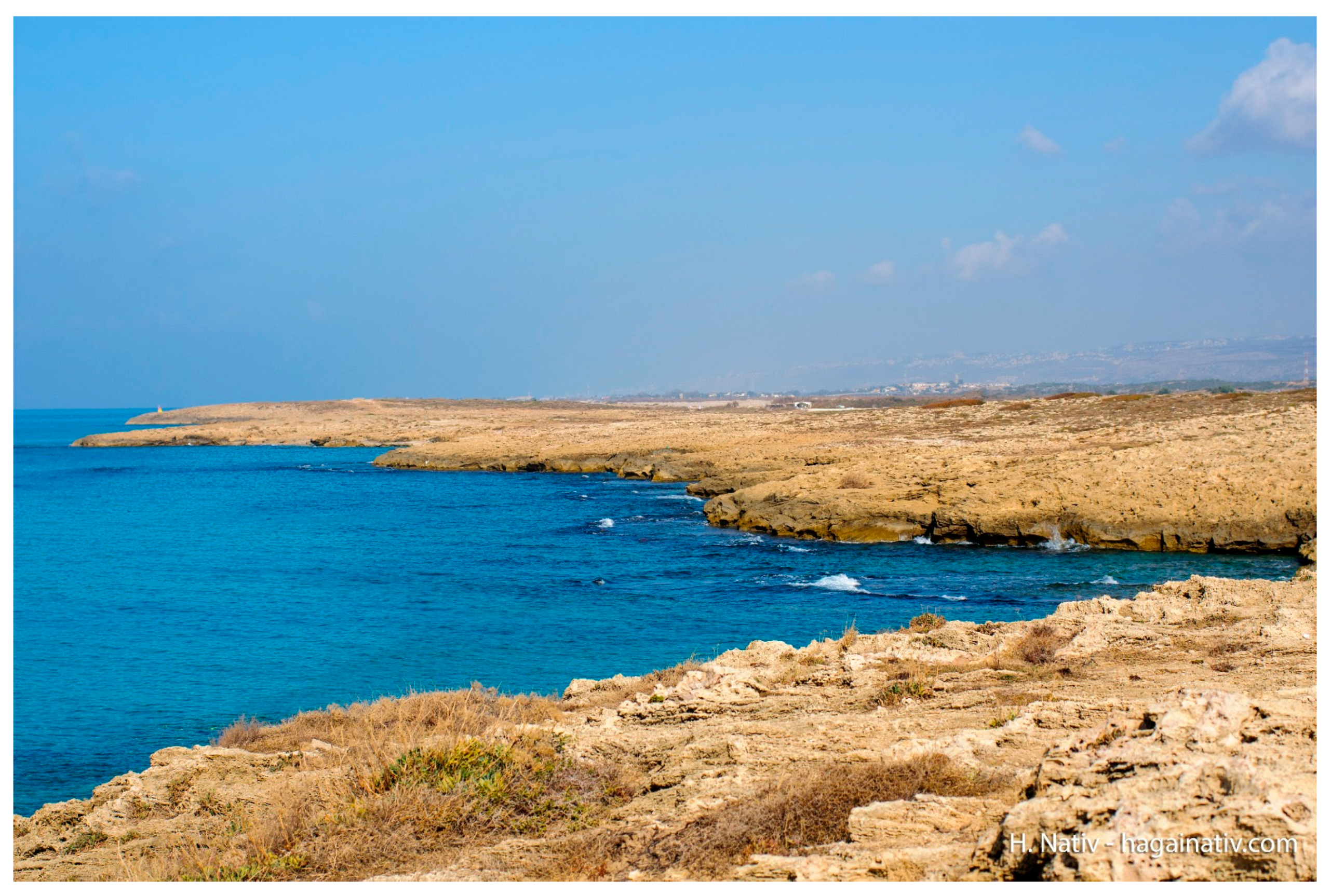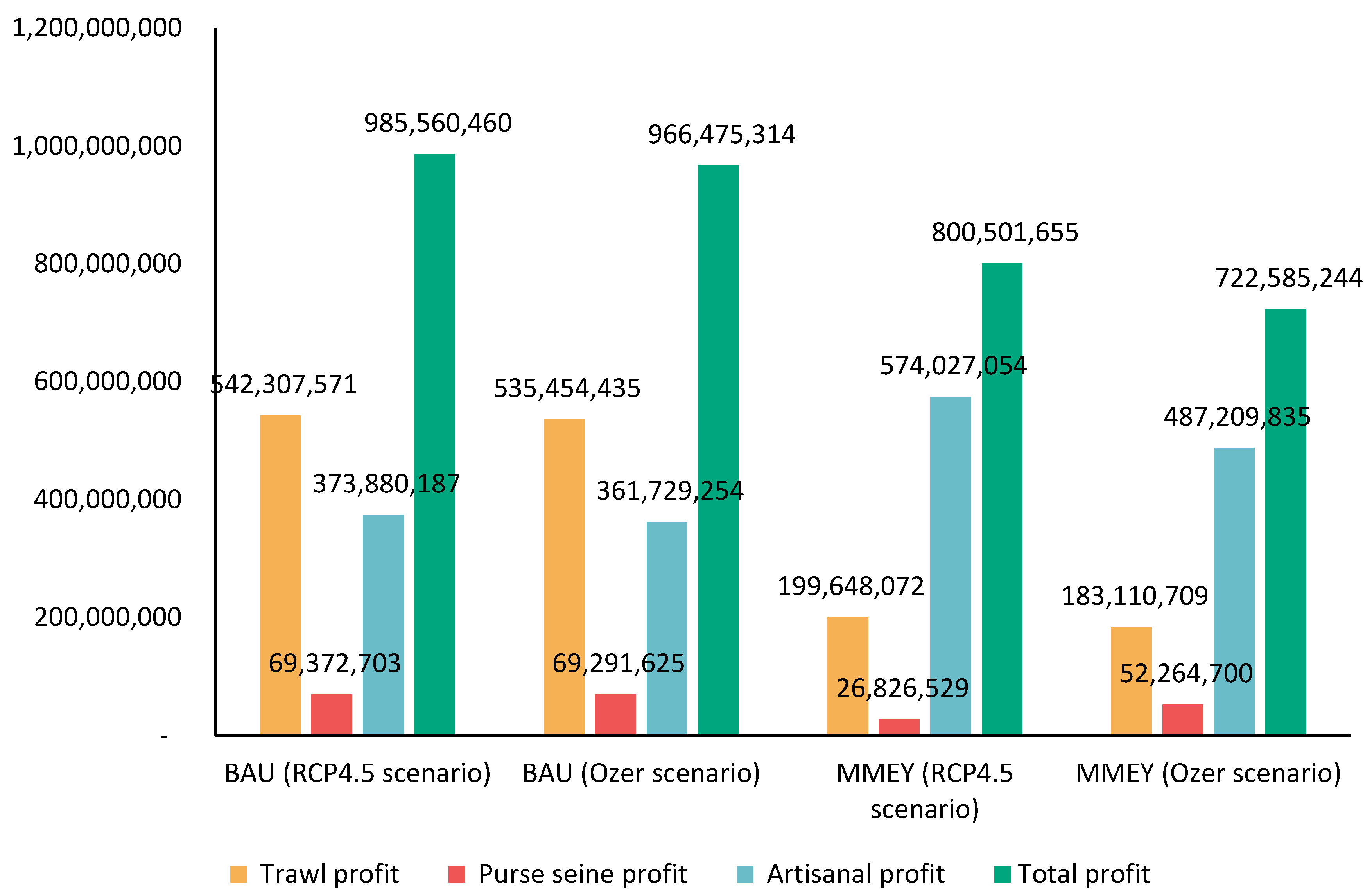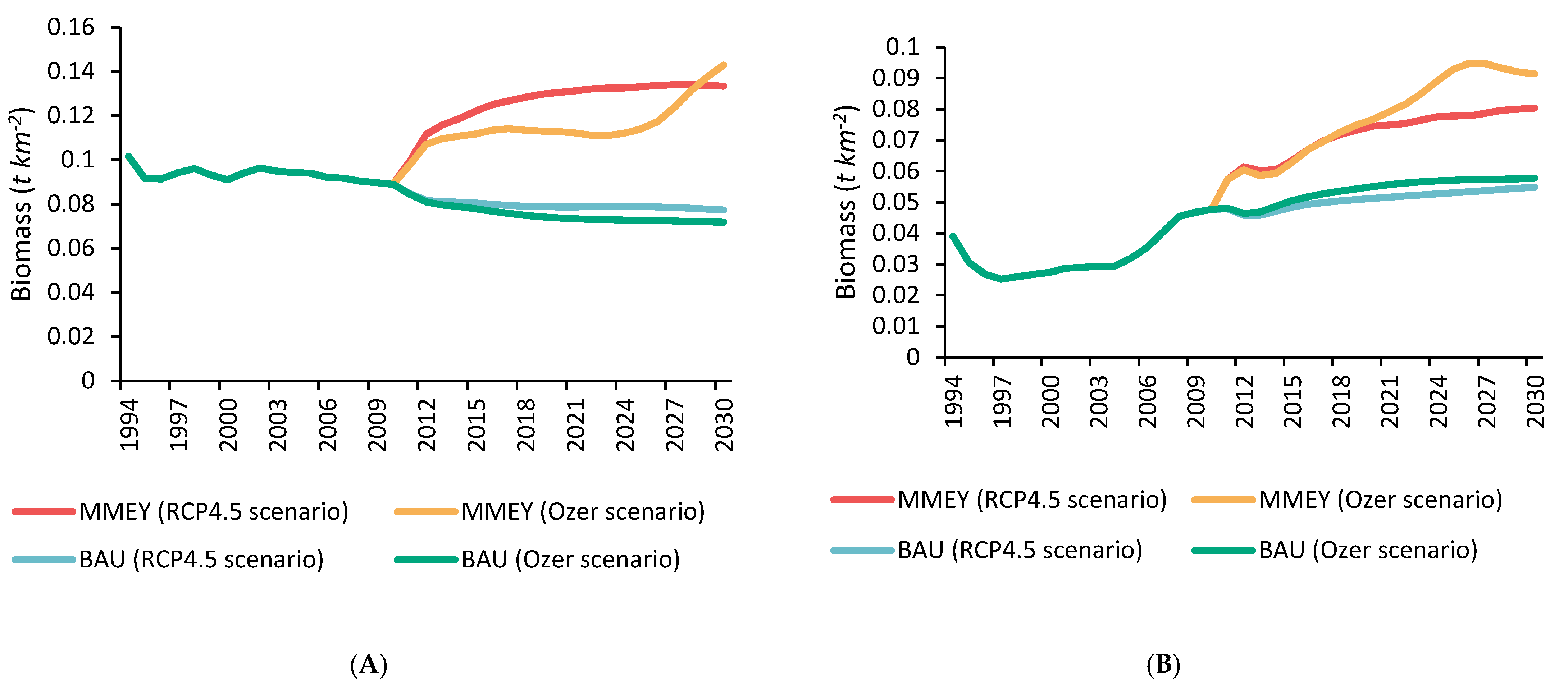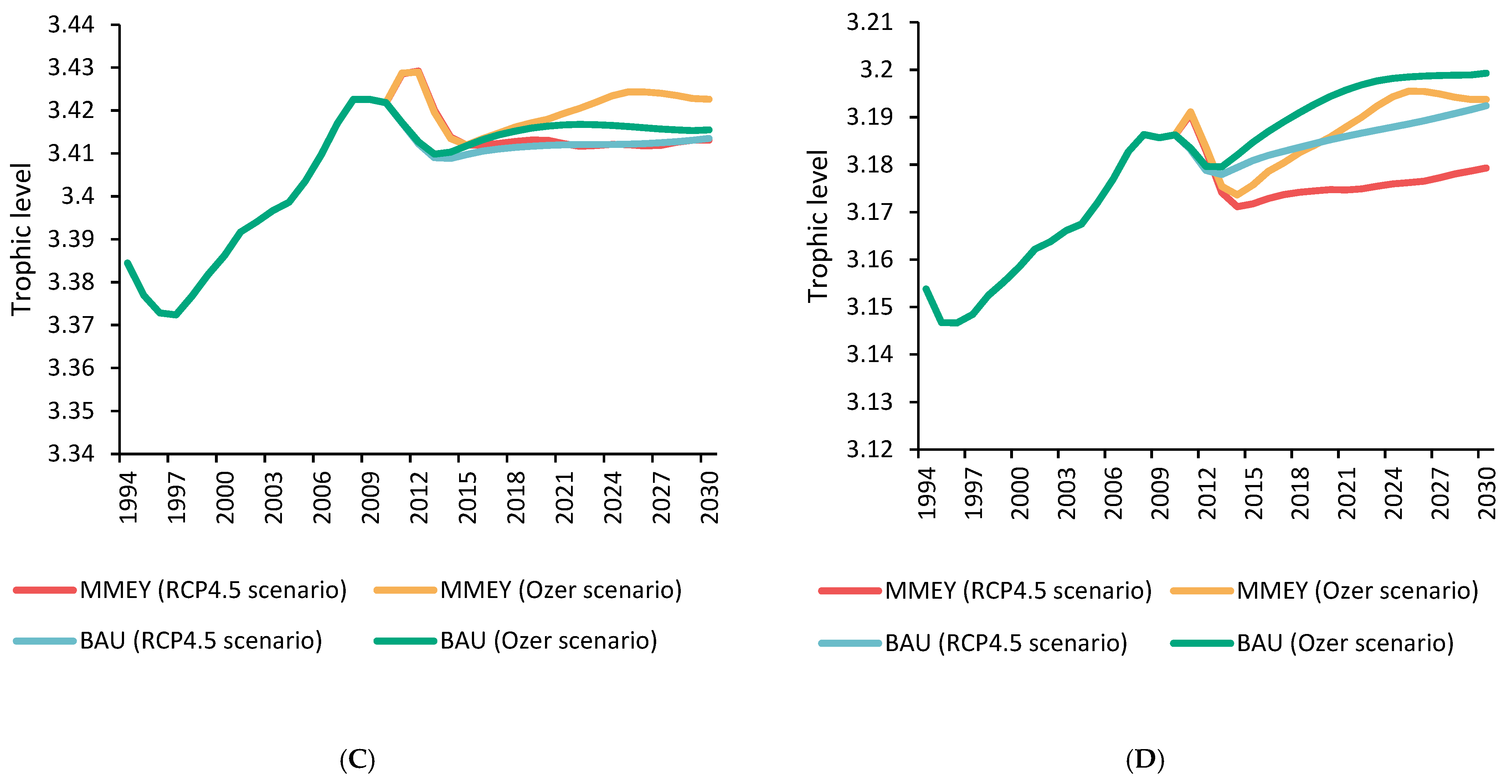Economic Valuation of Fish Provision, Wastewater Treatment, and Coastal Protection in the Israeli Mediterranean Sea
Abstract
1. Introduction
2. Materials and Methods
2.1. Economic Valuation Methods
2.2. Ecosystem Services Valuation
2.2.1. Food Provisioning
2.2.2. Wastewater Treatment
2.2.3. Coastal Protection
3. Results
3.1. Food Provisioning Valuation
3.2. Wastewater Treatment Valuation
3.3. Coastal Protection Valuation
4. Discussion
- The main hindrance detected in this study was the significant lack of ecological and physical data for the Israeli Mediterranean Sea. Up until a decade or so ago, investigations on the shallow and deep waters of the Israeli Mediterranean Sea were limited. Hence, our basic knowledge for accurate economic valuations was, in general, incomplete and rudimentary. Further understanding of the processes that govern this environment will grant us valuable information necessary for better management of the marine ecosystem;
- For the waste treatment ecosystem service, the need for a clear, detailed, and annual baseline nutrient balance (with the distinction between various nutrient input sources) is imperative. By providing model outputs relying on real data, one could calculate anthropogenic nutrient emissions and provide an ongoing understanding of the magnitude of benefits obtained by the local marine environment over time. Moreover, mapping of the spatial valuation of the benefits of this ecosystem service should be applied;
- For the coastal protection ecosystem service, the almost complete lack of data regarding the establishment and operational costs of potential artificial vermetid in supplying future ecosystem services proved to be a major difficulty. Further techno-ecological research and understanding of future threats to vermetid reefs are essential for the future.
Supplementary Materials
Author Contributions
Funding
Institutional Review Board Statement
Data Availability Statement
Acknowledgments
Conflicts of Interest
References
- Edelist, D.; Rilov, G.; Golani, D.; Carlton, J.T.; Spanier, E. Restructuring the Sea: Profound shifts in the world’s most invaded marine ecosystem. Divers. Distrib. 2013, 19, 69–77. [Google Scholar] [CrossRef]
- Michael-Bitton, G.; Gal, G.; Corrales, X.; Ofir, E.; Shechter, M.; Zemah-Shamir, S. Economic aspects of fish stock accounting as a renewable marine natural capital: The Eastern Mediterranean continental shelf ecosystem as a case study. Ecol. Econ. 2022, 200, 107539. [Google Scholar] [CrossRef]
- El-Geziry, T.M. Long-term changes in sea surface temperature (SST) within the southern Levantine Basin. Acta Oceanol. Sin. 2021, 40, 27–33. [Google Scholar] [CrossRef]
- Ozer, T.; Gertman, I.; Kress, N.; Silverman, J.; Herut, B. Interannual thermohaline (1979–2014) and nutrient (2002–2014) dynamics in the Levantine surface and intermediate water masses, SE Mediterranean Sea. Glob. Planet. Chang. 2016, 151, 60–67. [Google Scholar] [CrossRef]
- Galil, B.; Marchini, A.; Occhipinti-Ambrogi, A.; Ojaveer, H. The enlargement of the Suez Canal—Erythraean introductions and management challenges. Manag. Biol. Invasion 2017, 8, 141–152. [Google Scholar] [CrossRef]
- Xenarios, S.; Queiroga, H.; Lillebø, A.I.; Aleixo, A. Introducing a regulatory policy framework of bait fishing in European coastal lagoons: The case of Ria de Aveiro in Portugal. Fishes 2018, 3, 2. [Google Scholar] [CrossRef]
- Millennium Ecosystem Assessment (Ed.). Ecosystems and Human Well-Being: Synthesis; Island Press: Washington, DC, USA, 2005. [Google Scholar]
- Watson, R.; Baste, I.; Larigauderie, A.; Leadley, P.; Pascual, U.; Baptiste, B.; Mooney, H. Summary for Policymakers of the Global Assessment Report on Biodiversity and Ecosystem Services of the Intergovernmental Science-Policy Platform on Biodiversity and Ecosystem Services; IPBES Secretariat: Bonn, Germany, 2019; pp. 22–47. [Google Scholar]
- Earthscan. TEEB The Economics of Ecosystems and Biodiversity: Mainstreaming the Economics of Nature: A Synthesis of the Approach, Conclusions and Recommendations of TEEB; Earthscan: London, UK; Washington, DC, USA, 2010. [Google Scholar]
- Gómez-Baggethun, E.; de Groot, R.; Lomas, P.L.; Montes, C. The history of ecosystem services in economic theory and practice: From early notions to markets and payment schemes. Ecol. Econ. 2010, 69, 1209–1218. [Google Scholar] [CrossRef]
- Barbier, E.B. Marine ecosystem services. Curr. Biol. 2017, 27, R507–R510. [Google Scholar] [CrossRef]
- Austen, M.; Andersen, P.; Armstrong, C.; Döring, R.; Hynes, S.; Levrel, H.; Oinonen, S.; Ressurreição, A. Valuing Marine Ecosystems-Taking into account the value of ecosystem benefits in the Blue Economy. In Future Science Brief 5 of the European Marine Board; Center for Open Science: Ostend, Belgium, 2019; ISBN 9789492043696. [Google Scholar]
- Mehvar, S.; Filatova, T.; Dastgheib, A.; De Ruyter van Steveninck, E.; Ranasinghe, R. Quantifying economic value of coastal ecosystem services: A Review. J. Mar. Sci. Eng. 2018, 6, 5. [Google Scholar] [CrossRef]
- Hooper, T.; Börger, T.; Langmead, O.; Marcone, O.; Rees, S.E.; Rendon, O.; Austen, M. Applying the natural capital approach to decision making for the marine environment. Ecosyst. Serv. 2019, 38, 100947. [Google Scholar] [CrossRef]
- Available online: https://www.unep.org/unepmap/ (accessed on 15 October 2022).
- Peled, Y.; Zemah-Shamir, S.; Israel, A.; Shechter, M.; Ofir, E.; Gal, G. Incorporating insurance value into ecosystem services assessments: Mitigation of ecosystem users’ welfare uncertainty through biological control. Ecosyst. Serv. 2020, 1, 101192. [Google Scholar] [CrossRef]
- Peled, Y.; Shamir, S.Z.; Shechter, M.; Rahav, E.; Israel, A. A new perspective on valuating marine climate regulation: The Israeli Mediterranean as a case study. Ecosyst. Serv. 2018, 29, 83–90. [Google Scholar] [CrossRef]
- Mangos, A.; Basino, J.P.; Sauzade, D. Valeur Économique des Bénéfices Soutenables Provenant des Écosystèmes Marins Méditerranéens; Plan Bleu: Sophia Antipolis, France, 2010; p. 78. [Google Scholar]
- Barbier, E.B.; Hacker, S.D.; Kennedy, C.; Koch, E.W.; Stier, A.C.; Silliman, B.R. The value of estuarine and coastal ecosystem services. Ecol. Monog. 2011, 81, 169–193. [Google Scholar] [CrossRef]
- De Groot, R.; Brander, L.; Van Der Ploeg, S.; Costanza, R.; Bernard, F.; Braat, L.; Christie, M.; Crossman, N.; Ghermandi, A.; Hein, L.; et al. Global estimates of the value of ecosystems and their services in monetary units. Ecosyst. Serv. 2012, 1, 50–61. [Google Scholar] [CrossRef]
- Turner, K.G.; Anderson, S.; Gonzales-Chang, M.; Costanza, R.; Courville, S.; Dalgaard, T.; Wratten, S. A review of methods, data, and models to assess changes in the value of ecosystem services from land degradation and restoration. Ecol. Model. 2016, 319, 190–207. [Google Scholar] [CrossRef]
- Corrales, X.; Coll, M.; Ofir, E.; Heymans, J.J.; Steenbeek, J.; Goren, M.; Gal, G. Future scenarios of marine resources and ecosystem conditions in the Eastern Mediterranean under the impacts of fishing, alien species and sea warming. Sci. Rep. 2018, 8, 14284. [Google Scholar] [CrossRef]
- Christensen, V.; Walters, C.J.; Pauly, D. Ecopath with Ecosim: A user’s guide. Fish. Cent. Univ. Br. Columbia Vanc. 2005, 154, 31. [Google Scholar]
- Corrales, X.; Coll, M.; Ofir, E.; Piroddi, C.; Goren, M.; Edelist, D.; Gal, G. Hindcasting the dynamics of an Eastern Mediterranean marine ecosystem under the impacts of multiple stressors. Mar. Ecol. Prog. Ser. 2017, 580, 17–36. [Google Scholar] [CrossRef]
- Colléter, M.; Valls, A.; Guitton, J.; Gascuel, D.; Pauly, D.; Christensen, V. Global overview of the applications of the Ecopath with Ecosim modeling approach using the EcoBase models repository. Ecol. Model. 2015, 302, 42–53. [Google Scholar] [CrossRef]
- Stock, A.; Murray, C.C.; Gregr, E.; Steenbeek, J.; Woodburn, E.; Micheli, F.; Chan, K.M. Exploring multiple stressor effects with Ecopath, Ecosim, and Ecospace: Research designs, modeling techniques, and future directions. Sci. Total. Environ. 2023, 869, 161719. [Google Scholar] [CrossRef]
- Das, M.; Rahim, F.I.; Hossain, M.A. Evaluation of Fresh Azolla pinnata as a Low-Cost Supplemental Feed for Thai Silver Barb Barbonymus gonionotus. Fishes 2018, 3, 15. [Google Scholar] [CrossRef]
- Corrales, X.; Ofir, E.; Coll, M.; Goren, M.; Edelist, D.; Heymans, J.J.; Gal, G. Modeling the role and impact of alien species and fisheries on the Israeli marine continental shelf ecosystem. J. Mar. Syst. 2017, 170, 88–102. [Google Scholar] [CrossRef]
- Larimer, L.A. Compilation of Cost Data Associated with the Impacts and Control of Nutrient Pollution; EPA: Lexington, MA, USA, 2015. Available online: https://www.epa.gov/nutrient-policy-data/compilation-cost-data-associated-impacts-and-control-nutrient-pollution (accessed on 21 February 2023).
- Cossarini, G.; Feudale, L.; Teruzzi, A.; Bolzon, G.; Coidessa, G.; Solidoro, C.; Amadio, C.; Lazzari, P.; Brosich, A.; Di Biagio, V.; et al. High-resolution reanalysis of the Mediterranean Sea biogeochemistry (1999–2019). Front. Mar. Sci. 2021, 8, 741486. [Google Scholar] [CrossRef]
- Kress, N.; Rahav, E.; Silverman, J.; Herut, B. Environmental status of Israel’s Mediterranean coastal waters: Setting reference conditions and thresholds for nutrients, chlorophyll-a and suspended particulate matter. Mar. Poll. Bull. 2019, 141, 612–620. [Google Scholar] [CrossRef] [PubMed]
- USEPA Eastern Research Group, Inc. Life Cycle and Cost Assessments of Nutrient Removal Technologies in Wastewater Treatment Plants; 832-R- 21-006; EPA: Lexington, MA, USA, 2021. [Google Scholar]
- Zviely, D.; Bitan, M.; DiSegni, D.M. The effect of sea-level rise in the 21st century on marine structures along the Mediterranean coast of Israel: An evaluation of physical damage and adaptation cost. Appl. Geography. 2015, 57, 154–162. [Google Scholar] [CrossRef]
- Rilov, G. Israeli Mediterranean vermetid reef biodiversity monitoring data. PANGAEA 2019. [Google Scholar] [CrossRef]
- Safriel, U.N. Vermetid gastropods and intertidal reefs in Israel and Bermuda. Science 1974, 186, 1113–1115. [Google Scholar] [CrossRef]
- Spanier, E.; Zviely, D. Key Environmental Impacts along the Mediterranean Coast of Israel in the Last 100 Years. J. Mar. Sci. Eng. 2023, 11, 2. [Google Scholar] [CrossRef]
- Gordó-Vilaseca, C.; Templado, J.; Coll, M. The Need for Protection of Mediterranean Vermetid Reefs. 2021. Available online: https://www.sciencedirect.com/science/article/abs/pii/B9780128211397001021?via%3Dihub (accessed on 13 March 2023).
- Donnarumma, L.; Sandulli, R.; Appolloni, L.; Sánchez-Lizaso, J.L.; Russo, G.F. Assessment of structural and functional diversity of mollusc assemblages within vermetid bioconstructions. Diversity 2018, 10, 96. [Google Scholar] [CrossRef]
- Brokovich, E.; Abelson, A.; Ariel, A.; Ben-Yosef, D.; Goren, M.; Galil, B.; Yahel, R.; Mayzel, B.; Stambler, N.; Sivan, D.; et al. Abrasion Platforms in Israel: Status, Environmental Significance and Rehabilitation Possibilities before they Disappear. 2017. Available online: https://www.isees.org.il/wp-content/uploads/2016/09/gidud_booklet_web-last.pdf (accessed on 13 March 2023). (In Hebrew).
- La Marca, E.C.; Ape, F.; Martinez, M.; Rinaldi, A.; Montalto, V.; Scicchigno, E.; Dini, E.; Mirto, S. Implementation of artificial substrates for Dendropoma cristatum (Biondi 1859) reef restoration: Testing different materials and topographic designs. Ecol. Eng. 2022, 183, 106765. [Google Scholar] [CrossRef]
- Perkol-Finkel, S. (ECOncrete Tech Ltd., Tel Aviv, Israel). Personal communication, 2019.
- Chaikin, S.; Dubiner, S.; Belmaker, J. Cold-water species deepen to escape warm water temperatures. Global. Ecol. Biogeogr. 2022, 31, 75–88. [Google Scholar] [CrossRef]
- Brehmer, P.; Do Chi, T.; Laugier, T.; Galgani, F.; Laloë, F.; Darnaude, A.M.; Fiandrino, A.; Mouillot, D. Field investigations and multi-indicators for shallow water lagoon management: Perspective for societal benefit. Aquat. Conserv. Mar. Freshw. Ecosyst. 2011, 21, 728–742. [Google Scholar] [CrossRef]





| Ecosystem Services Type | Ecosystem Service | Description |
|---|---|---|
| Provisioning | Fish food provisioning | Ecosystem’s ability to provide consumable biomass (fisheries and mariculture) |
| Regulating | Wastewater treatment | Absorption and decontamination of effluents in the coastal and marine environment |
| Coastal protection | Provide physical protection against coastal damages (storms and waves) |
| Valuation Method | Type of Value | Method Description |
|---|---|---|
| Market price | Use | Prices reflect willingness to pay for consumable products |
| Replacement cost | Use | Cost of replacing ecosystem services serves as proxy for their economic value |
| Nitrogen | Phosphorus | |||||||||
|---|---|---|---|---|---|---|---|---|---|---|
| 2016 | 2017 | 2018 | 2019 | 2020 | 2016 | 2017 | 2018 | 2019 | 2020 | |
| Ecosystem efficiency (%) | 75 | 96 | 99 | 98 | 73 | 75 | 95 | 93 | 99 | 66 |
| Wastewater treatment valuation (million NIS) | 96.2 | 16.3 | 76.8 | 86.5 | 70.8 | 268.3 | 59.5 | 103.2 | 122.5 | 77.3 |
| High Estimate | Low Estimate | ||
|---|---|---|---|
| Fixed costs | |||
| The cost abrasion platform | 100,000 | 100,000 | NIS |
| Unit area | 16.0 | 16.0 | m2 |
| Unit cost per sqm | 6250 | 6250 | NIS |
| The cost of construction and construction as a percentage of the cost of a unit | 10 | 10 | % |
| The area of all abrasion platform | 877,776 | 877,776 | sqr |
| Percentage of overwrite of abrasion platform | 3 | 1 | % |
| Space for switching abrasion platform | 26,333 | 8778 | m2 |
| Fixed Costs | 181,041,306 | 60,347,102 | NIS |
| Variable costs | |||
| Annual monitoring cost as a percentage of unit cost | 4 | 2 | % |
| Annual maintenance cost as a percentage of a unit cost | 10 | 5 | % |
| Total variable costs | 1,440,101 | 240,017 | NIS |
| NPV (30 years) | 28,226,621 | 4,704,437 | NIS |
| Total costs | 209,267,927 | 65,051,539 | NIS |
Disclaimer/Publisher’s Note: The statements, opinions and data contained in all publications are solely those of the individual author(s) and contributor(s) and not of MDPI and/or the editor(s). MDPI and/or the editor(s) disclaim responsibility for any injury to people or property resulting from any ideas, methods, instructions or products referred to in the content. |
© 2023 by the authors. Licensee MDPI, Basel, Switzerland. This article is an open access article distributed under the terms and conditions of the Creative Commons Attribution (CC BY) license (https://creativecommons.org/licenses/by/4.0/).
Share and Cite
Zemah-Shamir, S.; Peled, Y.; Shechter, M.; Israel, Á.; Ofir, E.; Gal, G. Economic Valuation of Fish Provision, Wastewater Treatment, and Coastal Protection in the Israeli Mediterranean Sea. Fishes 2023, 8, 236. https://doi.org/10.3390/fishes8050236
Zemah-Shamir S, Peled Y, Shechter M, Israel Á, Ofir E, Gal G. Economic Valuation of Fish Provision, Wastewater Treatment, and Coastal Protection in the Israeli Mediterranean Sea. Fishes. 2023; 8(5):236. https://doi.org/10.3390/fishes8050236
Chicago/Turabian StyleZemah-Shamir, Shiri, Yoav Peled, Mordechai Shechter, Álvaro Israel, Eyal Ofir, and Gideon Gal. 2023. "Economic Valuation of Fish Provision, Wastewater Treatment, and Coastal Protection in the Israeli Mediterranean Sea" Fishes 8, no. 5: 236. https://doi.org/10.3390/fishes8050236
APA StyleZemah-Shamir, S., Peled, Y., Shechter, M., Israel, Á., Ofir, E., & Gal, G. (2023). Economic Valuation of Fish Provision, Wastewater Treatment, and Coastal Protection in the Israeli Mediterranean Sea. Fishes, 8(5), 236. https://doi.org/10.3390/fishes8050236







